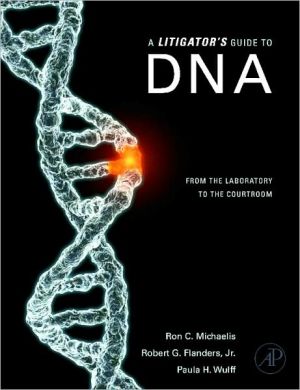

 |

|

Sold Out
Book Categories |
Acknowledgments xi
Introduction xiii
The Structure of DNA and the Variability of the Human DNA Sequence 1
You Are Out of Your Field, But Not Out of Your Depth 1
Markers, Alleles, Genotypes and Profiles 2
The Two Sources of DNA in Human Cells 5
The Structure of DNA and RNA 6
Variability Is the Rule, Not the Exception 11
Polymorphisms Commonly Used for Forensic Testing 15
Using the DNA Profile to Identify an Unknown Perpetrator 24
References and Additional Readings 25
The Molecular Biological Basis of Forensic DNA Tests 27
Extraction and Quantification of DNA 27
Polymerase Chain Reaction (PCR)-Based Tests 32
Variable Number of Tandem Repeats (VNTR) Testing 50
Direct Sequencing 51
References and Additional Readings 53
Quality Control, Quality Assurance and Sources of Uncertainty in the Data 55
Laboratory Accreditation, Personnel Certification and Proficiency Testing 55
Validation Studies 59
The Inevitable Nemeses: Suboptimal Samples and Human Error 61
Allele Dropout Due to Degradation, Preferential Amplification and StochasticEffects 70
Artifacts Inherent in STR Analyses 75
Hybridization Specificity in Dot-Blot Tests 87
References and Additional Readings 88
Population Genetics, Probability Calculations and the Proper Interpretation of the Evidence 91
The Common Logical Fallacies 91
Databanks and Databases 99
Allele Frequencies, Genotype Probabilities and the Product Rule for Independent Events 106
The Principles of Population Genetics that Impact Forensic DNA Calculations 113
Applying the Product Rule-Compensating for Population Substructure and Possible Allele Dropout 119
The Likelihood Ratio (LR) Allows the Analyst to Compare the Strength of Competing Hypotheses 135
The Application of Bayes' Theorem to Paternity Disputes 142
Recommended Procedure for Analyzing Mixed Samples 147
References and Additional Readings 167
Mitochondrial DNA (mtDNA) Analyses 171
The mtDNA Molecule-Abundant and Durable but Less Variable than nDNA 171
Laboratory Analysis of mtDNA Haplotypes 174
Matrilineal Inheritance and a Lack of Recombination 178
A High Mutation Rate Leads to Mitochondrial Heteroplasmy 180
Statistical Analysis of mtDNA Haplotype Data 187
References and Additional Readings 193
Y Chromosome Analyses 197
Y Chromosome Evolution and its Consequences for Forensic Analyses 197
Laboratory Analysis of Y Chromosome Haplotypes 204
Statistical Analysis of Y Chromosome Haplotypes 207
References and Additional Readings 212
DNA in Court 215
The Evolution of Standards for Admissibility of Experts and Evidence 215
The Ongoing Controversy Regarding Laboratory Error Rates 225
Counsels' Obligations Regarding Discovery 228
Expert Witnesses 232
The Durability of DNA Presents Problems for Statutes of Limitation 237
Rape Shield Laws May Limit the Use of DNA Evidence 238
Judges' and Jurors' Perceptions of DNA Evidence 239
References and Additional Readings 253
Arguing for the Prosecution 255
Obtaining DNA Samples 255
DNA in the Courtroom: The Essentials of the Prosecution's Presentation 279
References and Additional Readings 312
Arguing for the Defense 313
The Defense's Choice of Strategy 313
Elements of a Competent Defense 326
When the Defendant Has Been Identified by a Databank Search 362
References and Additional Readings 367
Postconviction DNA Testing 369
DNA has the Power to Exonerate the Innocent 369
Avenues for Relief 370
There Are Many Procedural Obstacles 373
New Evidence May Justify a New Theory of the Case 379
Accessing the Necessary Samples 380
Know the Specific Provisions of the Controlling Statute 383
References and Additional Readings 386
Using the Chi-Square Test to Determine if a Population Conforms to HWE Expectations 389
How the RMP, Prior Odds of Guilt, and the PFP Influence the Posterior Odds of Guilt (POG) 393
Paternity Index (PI) Calculations for Different Combinations of Maternal, Child and Alleged Father Genotypes 397
A Sample Consent Form to Collect an Oral Swab, Which Allows the Profile Obtained to Be Entered Into a Databank for Use in Additional Investigations 399
Doing Your Own Research: Useful References, Websites and Strategies for Finding Current Information 401
Glossary of Key Terms 411
Index 423
Login|Complaints|Blog|Games|Digital Media|Souls|Obituary|Contact Us|FAQ
CAN'T FIND WHAT YOU'RE LOOKING FOR? CLICK HERE!!! X
 You must be logged in to add to WishlistX
 This item is in your Wish ListX
 This item is in your CollectionA Litigator's Guide to DNA: From the Laboratory to the Courtroom
X
 This Item is in Your InventoryA Litigator's Guide to DNA: From the Laboratory to the Courtroom
X
 You must be logged in to review the productsX
 X
 X

Add A Litigator's Guide to DNA: From the Laboratory to the Courtroom, A Litigator's Guide to DNA educates litigators, judges, criminalists, students, and others about all aspects of the use of DNA evidence in criminal and civil trials. It includes discussions of the molecular biological basis for the tests, essential, A Litigator's Guide to DNA: From the Laboratory to the Courtroom to the inventory that you are selling on WonderClubX
 X

Add A Litigator's Guide to DNA: From the Laboratory to the Courtroom, A Litigator's Guide to DNA educates litigators, judges, criminalists, students, and others about all aspects of the use of DNA evidence in criminal and civil trials. It includes discussions of the molecular biological basis for the tests, essential, A Litigator's Guide to DNA: From the Laboratory to the Courtroom to your collection on WonderClub |